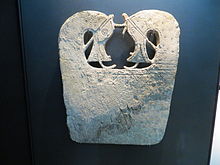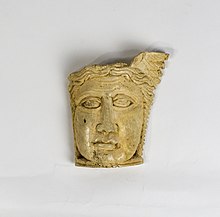Bone carving


Bone carving is creating art, tools, and other goods by carving animal bones, antlers, and horns. It can result in the ornamentation of a bone by engraving, painting or another technique, or the creation of a distinct formed object. Bone carving has been practiced by a variety of world cultures, sometimes as a cheaper, and recently a legal, substitute for ivory carving.[2] As a material it is inferior to ivory in terms of hardness, and so the fine detail that is possible, and lacks the "lustrous" surface of ivory. The interior of bones are softer and even less capable of a fine finish, so most uses are as thin plaques, rather than sculpture in the round.[3] But it must always have been much easier to obtain in regions without populations of elephants, walrus or other sources of ivory.
It was important in prehistoric art, with notable figures like the Swimming Reindeer, made of antler, and many of the Venus figurines. The Anglo-Saxon Franks Casket is a whale bone casket imitating earlier ivory ones.[4] Medieval bone caskets were made by the Embriachi workshop of north Italy (c. 1375–1425) and others, mostly using rows of thin plaques carved in relief.[5]

Flat bones were also used by artists and craftsmen to try out their designs, especially by metalworkers. Such pieces are known as "trial-pieces".
In July 2021, scientists reported the discovery of a bone carving, one of the world's oldest works of art, made by Neanderthals about 51,000 years ago.[6][7]
Both whalebone (baleen) and the normal skeletal whale bones were often carved, especially for scrimshaw and in the Middle Ages.
References[edit]
- ^ "plaque / food-tray / culinary equipment / chopping-board". British Museum. Archived from the original on 3 March 2016. Retrieved 26 April 2018.
- ^ Sims, Margaret E.; Baker, Barry W.; Hoesch, Robert M. (2011). "Tusk or Bone? An Example of Ivory Substitute in the Wildlife Trade". Ethnobiology Letters. 2: 40–45. doi:10.14237/ebl.2.2011.27. JSTOR 26419931.
- ^ Osborne, 145
- ^ Osborne, 145
- ^ "Casket", Art Institute of Chicago
- ^ Feehly, Conor (6 July 2021). "Beautiful Bone Carving From 51,000 Years Ago Is Changing Our View of Neanderthals". ScienceAlert. Retrieved 6 July 2021.
- ^ Leder, Dirk; et al. (5 July 2021). "A 51,000-year-old engraved bone reveals Neanderthals' capacity for symbolic behaviour". Nature Ecology & Evolution. 594 (9): 1273–1282. Bibcode:2021NatEE...5.1273L. doi:10.1038/s41559-021-01487-z. PMID 34226702. S2CID 235746596. Retrieved 6 July 2021.
- Osborne, Harold (ed), The Oxford Companion to Art, 1970, OUP, ISBN 019866107X
